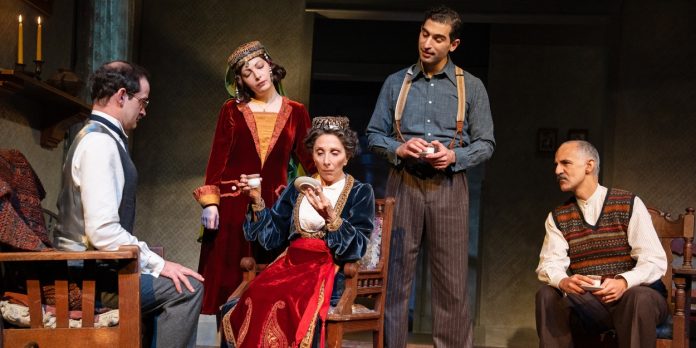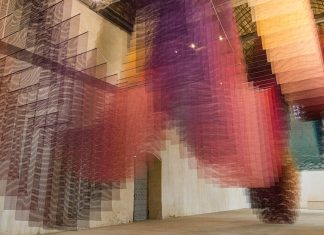The critics stopped by Meet the Cartozians at the Irene Diamond Stage at the Pershing Square Signature Center starring Raffi Barsoumian, Will Brill, Andrea Martin, Nael Nacer, Susan Pourfar, and Tamara Sevunts. Read the reviews in our roundup below!
This bold, witty new play follows two sets of Armenian Americans: one man fighting for legal recognition in the 1920s, while a century later, his descendant fights for followers and a competent glam team. MEET THE CARTOZIANS asks who gets to belong—and at what cost?
Meet The Cartozians is written by Talene Monahon is directed by David Cromer.

Robert Hofler, The Wrap: David Cromer directs, and a hallmark of his many stellar productions is the actors’ comic timing. No one directs comedy better than Cromer; he invariably finds the humor in adversity. And there’s something else that makes him one of the great directors: He champions and takes on plays by writers even an avid theatergoer has probably never heard of. This autumn, he preceded “Cartozians” with the exquisite “Caroline” by Preston Max Allen. If Cromer is directing, you know it’s worth seeing.

Bob Verini, New York Stage Review: Diverted as they are, some audience members will likely wish for more closure in the play’s themes and subplots. If there’s sentiment that several of the scenes could be trimmed, I can’t disagree. Still, there’s no denying the poignancy of Monahon’s coda, which simply and delicately brings two Armenian Americans together on the most basic human level. Which is surely where we should all have been meeting Cardozians, and each other, all along.

Michael Sommers, New York Stage Review: Aptly dressed for yesteryear and today by Enver Chakartash, the ensemble offers solid, distinctive performances. Always an audience favorite, Andrea Martin first appears totally authentic as a commonsensical old world grandma who reads the future in coffee cups and then she raises laughter as an opinionated senior citizen not to be trifled with. Nael Nacer lends a dignified presence to his Tatos Cartozian and as a longtime civic leader. Will Brill gradually reveals an irritable streak that festers within the lawyer and the camera guy he portrays. Like their colleagues, Tamara Sevunts, Raffi Barsoumian and Susan Parfour create detailed characters who look as if their lives extend beyond the confines of a proscenium stage.

Amelia Merrill, New York Theatre Guide: Too often, modern political theatre forces characters to parrot a mantra the audience already believes, a reassurance that you and the playwright voted for the same people and did the right thing by coming to the theatre. Meet the Cartozians should not leave anyone feeling this misplaced sense of gratification.

Melissa Rose Bernardo, Time Out New York: In the 1925 court case United States v. Cartozian, the U.S. government sued to revoke the citizenship of a man named Tatos Cartozian, on the grounds that Armenians like him weren’t white. The Armenian-American playwright Talene Monahon has now worked that story into Meet the Cartozians, a sprawling, fascinating work of historical fiction that examines ethnicity, history and family legacy.

Jackson McHenry, Vulture: A Conversion on the Road to Calabasas: Meet the Cartozians
Portrait of Jackson McHenry
By Jackson McHenry, a Vulture critic covering theater, film, and TV
10:00 P.M.
save
Comment
From ‘Meet the Cartozians,’ at the Pershing Square Signature Center.
From Meet the Cartozians, at the Pershing Square Signature Center. Photo: Julieta Cervantes
“I’m going home,” an Armenian American matriarch announces as she storms out of a reality-TV taping in Glendale, clutching her oversize purse. “To Calabasas.” It’s a typically sharp laugh line from the playwright Talene Monahon, delivered with the level of comedic precision that only someone like Andrea Martin could attain—she really knows how to revel in the comedy of a hard consonant—that cuts quick and cleanly, and then, like a lot of Meet the Cartozians, leaves a throbbing, unclotted wound. The pain all has to do with that tricky final word, “home,” which recurs throughout Monahon’s time-hopping drama of assimilation. In the play’s second act, Martin’s character, Rose, shows up to discuss her culture with other Armenians at a taping of a Christmas episode of a show that is, in all but name, Keeping Up With the Kardashians. (In the universe of the play, the reality show bears the play’s title.) They bicker, of course. Monahon is doing an enjoyable send-up of SoCal superficiality, and of course Rose, a wealthy traditionalist, lives in the same comfortable enclave as Kris Jenner. But how much of a home is Calabasas? It’s a refuge, of a sort, and a place of comfort for Rose. I’m sure she loves the Erewhon. But is it where she belongs, where she wants to belong, or somewhere that even wants her?
By that point in Meet the Cartozians, we’ve already spent an act with Martin and the rest of the cast in a different era, pondering the same questions 100 years earlier in a different register. Before she gets to the reality-TV satire, Monahon kicks off her play with a stouter, though often still bitingly funny, historical reenactment. In Portland in the early 1920s, an Armenian family, the Cartozians, meet with an American lawyer, Wallace McCamant (Will Brill), after the patriarch, Tatos (Nael Nacer), has been denied citizenship, seemingly based on the color of his skin. His brother Aram, he reminds McCamant, was naturalized a few years earlier without issue. They are assembling their arguments for what would become a real and landmark court case, United States v. Cartozian, with far-reaching implications for those fleeing the Armenian genocide. The surreal terms of American immigration law as it stood at the time were that “free white persons of good character” could be naturalized, as well as those of African descent. This left out most other groups, and although challenges from Japanese and Indian immigrants had failed by the time of the Cartozian case, the real McCamant successfully argued that Armenians were white enough in culture and looks to meet the definition. (A photo of Cartozian and his daughters looking as assimilated as possible was published in a local paper as a crucial out-of-court argument.) As Brill’s McCamant explains this onstage, the matriarch of the Cartozian family, Markrid, also played by Martin, happily netting three-pointer physical comedy in the way she wields desserts, interjects in unsubtitled Armenian, “Asīga īnč əsél é, ‘white person’?” Or, What does this mean, “white person”? You understand the question without translation, though you’d be hard pressed, then or now, to answer her with precision.
In the first act, Monahon and her director David Cromer infuse the absurdity of that legal case into the weft of the play, allowing the facts of history to shimmer with dark humor. Nacer’s excellent as the dutiful and serious Tatos, committed to winning his case no matter what, even as his children differ about what should be sacrificed to perform sufficient whiteness. His hard-charging son, Vahan, played with heat by Raffi Barsoumian, is happy to leave traditions behind to get ahead, while their gentler daughter, Hazel, played with grace by Tamara Sevunts, holds onto the old ways. Monahon’s dialogue can overwhelm you with jargon—you have the sense that she has research to get off her chest, and she wants you to learn it all too—but she also has an impressive gift for knowing how to keep flipping and reversing her characters’ expectations. Vahan, the most committed to Americanization, has the darkest and hairiest complexion, and would be least able to provide a convincingly European-ish mien in court. Hazel, meanwhile, is developing a dangerous fondness for McCamant. Then, even as they pursue the white whale of Americanization, the Cartozians are banking on exoticism. They advertise their oriental carpet business with the image of a camel. “Are there camels in Armenia?” asks McCamant, terrified that this will leave people thinking that they’re Arab “Mohammadens,” rather than the upstanding Christians he’s portraying. “Don’t be crazy!” Vahan tells him.
A century later, in Monahon’s bracing second act, you’ll notice Martin’s Rose quoting an “old Armenian saying” about a camel. By then, the going exchange rate for whiteness, so to speak, has shifted. The members of Cartozians’s cast have all been shuffled into new roles. Everyone’s sitting on a couch in front of gold wine glasses while wearing gaudy renditions of traditional outfits—the on-point costumes are by Enver Chakartash—ready to raise awareness about Armenian history by talking with “The Celebrity” about her own culture, if she ever makes it out of hair and makeup. Brill, in his groove as another kind of wheedling Irish American observer, is now the harried camera operator apologizing for the delays. Monahon indulges in some satire of Hollywood vapidness, and the empty chair where her Kim Kardashian figure would sit is marked by the presence of a Stanley cup and a salad; she also turns toward legal debate. One of the invitees to the couch, a prim poet and activist played by Susan Pourfar, tries to use her time on camera to discuss a push for a subcategory for Armenian-Americans among the newly defined census classification of Middle Eastern and North Africans, which she insists would allow for better data collection. (Gavin Newsom recently signed a California bill doing so into law.) Rose, on the other hand, insists that being grouped with white people, the result of the hard battle we’ve seen in the first act, should not be given up. In this argument, just as the previous court case, there’s another flurry of starchy terms—Monahon has a lot of fun making the characters swat around acronyms like they’re playing pickleball—undergirded by an awareness of the fickle yet immense power that racial classification holds in America. The play’s double-casting underlines the strange in-and-outness of assimilation. (Tatiana Kahvegian’s set encourages double vision, too; the walls of her realistic rendering of the Cartozians’ 1920s home are pushed back and to the sides of the stage but still visible, a carapace around the brightly-lit 2020s “reality.”) Barsoumian, once the ambitious too-dark Vahan, is now a reedy university professor griping about being overlooked for tenure because he says he was seen as another white man. He also says the things about “The Celebrity” that everyone else is too polite to mention. When he’s set off, he revs himself into a blistering tirade about how she’s made a career by playing with both sides of whiteness: “You wanna talk about the f-ing self-tanner???”
Were Monahon merely to continue on with that back-and-forth, the second act of Meet the Cartozians might just be an enjoyable flame war, but she knows how to let the bottom drop out. A breathless stretch of humor, in the play, will crest and then be punctuated by a dark turn, or, in a mode at which her director Cromer excels, a haunting and meditative stillness. Though the Cartozians prefer to bury their memories, Monahon does not let her audience forget that this family was fleeing near-complete elimination. Before we see Pourfar as that activist poet, we see her as a character deeply touched by the trauma of genocide. This family must find a way to belong in America, because, as Nacer’s Tatos tries to put it to his lawyer, “There is no longer actually Armenia. It is no longer a place.” One hundred years later, Nacer is a soft-spoken community leader named Robert who, in a touching grace note, holds genuine fondness for The Celebrity. (Monahon has also given him a significant first name.) Nacer allows those memories of Tatos to resonate through his remarkably subtle and engaging performance, the characters almost merging in homesickness. Robert, as it turns out, has been back to Armenia, made a trip that Tatos might not have been able to fathom. The play leaves the question open: Was that a journey forward, or back? Toward home, or away from it?

Average Rating:
85.0%
.







